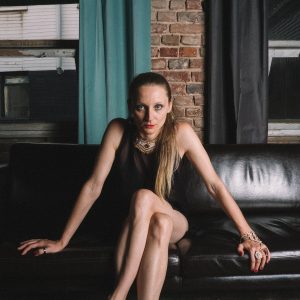MONIKA PICH: SIMULTANEOUS SPACES
ZUIHITSU
QUIRKY THOUGHTS COLLECTION
Essays, personal stories and curiosities from our guest fem人le contributors
MONIKA PICH: SIMULTANEOUS SPACES
We have multi-media instruments that allow us to build new sensory compositions evoking deep feelings through participation. I will describe my original project based on my personal audio experiences. They may expand the topic of the role of sound in action art.
Everyone Is a World, The Shop Windows of Art, UAP, 7 Gwarna Street, Poznań, Poland 12 March 2021

During the pandemic, I was invited to carry out an artistic work as part of the Shop Windows of Art curator project organised by the Magdalena Abakanowicz University of the Arts in Poznań (UAP) in an empty space of a former commercial and service premises in the city centre of Poznań. The place seemed to be a great meeting place. Next to it, there was a tram stop, a kebab bar, Indian and Korean grocery stores, a Żabka convenience store, a pharmacy and a hairdresser. This fairly large variety of establishments encouraged me to participate in the project. I wondered what I should present in order to keep social distancing, draw the audience’s attention to the problem of social atomisation and, at the same time, show the interrelationships and give all of it a coherent structure. I decided to create a living, processual activity that would allow for direct participation in the event. I came up with the idea of a performative audio-visual art performance modelled on instrumental theatre. ‘Its action, free from the plot axis and cause-effect sequences, subjected to the laws of chance, took place spontaneously.’ (Z. Skowron, Nowa muzyka amerykańska, Kraków: Musica Jagellonica, 1995, p. 305.)
The performance combined an improvised piece of music with the actors’ movements and gestures, phonically treated words, light and stage setting – all these elements were completely subordinated to each other, creating a ‘network of connections’ (Bruno Latour, Reassembling the Social: An Introduction to Actor-Network-Theory, New York: Oxford University Press, 2005.)
The presence of actors playing their roles with the use of props creating sensory space (similar to the foley technique) influenced the shape and structure of the sound piece. There were sounds of fat sucked with a humming vacuum cleaner, rustling steps taken by an actor walking on litter in a cat litter box, rhythmic boxing, penetrating radio waves, mantric bells attached to a dancing hand, impulsive drawing, and minimal squeaking of an egg shell supported by the head. The sounds were picked up inside the room by microphones focused on the actors’ gestures, mixed in real time and conveyed outside the window of the site where the performance took place.
In this way, several parallel worlds of different sounds were produced: external, internal and also those created by individuals. Inside the room, there was a chaos of overlapping foley sounds generated by the actors, while outside, the audience heard the same sounds (some of them modulated) in an integrated mix. The result was an elaborate soundtrack for a picture that appeared to be static/mannequin but it actually fuelled the dynamics of the action. The sound raised associations, focusing the eyes and attention of the audience. The instrumental actors became part of a score based on excerpts from the 1984 volume of poetry entitled ‘Everyone is a World’ by the Swedish poet Gunnar Ekelöf. It is poetry of rational opposites, contrasts and paradoxes – still valid in today’s world.
You say ‘I’ and ‘it is about me’ but the point is that you are actually nobody! Reality is so selfless, naked and formless! It was in fear of reality that you started to dress, behave and call yourself ‘I’ … Legal order, human dignity, free will, all these – pictures painted with fear in an empty room of reality, with fear of recognising something beyond the law and lawlessness, a thesis and an antithesis!
G. Ekelöf, Każdy człowiek jest światem, (trans.) J. B. Roszkowski, Z Wawrzyniak, Kraków-Wrocław: Wydawnictwo Literackie, 1984, p. 16 (my translation).
Photography/ Documents of the performative action ‘Everyone Is a World’, by Sonia Bober, 2021

Monika Pich is a multimedia artist living in Poland. She is a practitioner and a theoretician of art and communication, a documentalist, a music composer, a vocalist, a radio and film sound designer and a field recording artist. She focuses on the problem of the space-time multidimensionality of the world and the issues of cognitive processes and stylistic and semantic interpretation. She deals with the analysis of the quality of content, form and reception of media messages, as well as multimedia translations. She is also an art teacher, a curator and the author of creative educational concepts and workshops. She performs individual musical projects and collaborates with artists and international musicians. She is a producer of a radioshow “Space Oddity Recollection” that airs monthly on Radio Teslafm.
